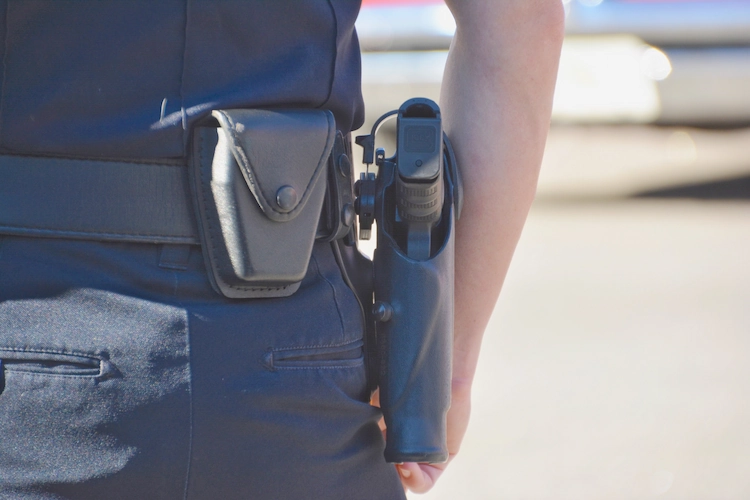Supreme Court Rejects Moment of Threat Doctrine in Deadly Force Case

In Barnes v. Felix, 605 U.S. ____ (2025), the U.S. Supreme Court rejected the Fifth Circuit Court of Appeal’s “moment of threat” doctrine, which focused solely on the immediate actions leading up to a police officer’s use of force. In so ruling, Court reaffirmed that an inquiry into the reasonableness of police force requires analyzing the “totality of the circumstances.”
Facts of the Case
Respondent Roberto Felix, Jr., a law enforcement officer, pulled over Ashtian Barnes for suspected toll violations. Felix ordered Barnes to exit the vehicle, but Barnes began to drive away. As the car began to move forward, Felix jumped onto its doorsill and fired two shots inside. Barnes was fatally hit but managed to stop the car. About five seconds elapsed between when the car started moving and when it stopped. Two seconds passed between the moment Felix stepped on the doorsill and the moment he fired his first shot.
Barnes’s mother sued Felix on Barnes’s behalf, alleging that Felix violated Barnes’s Fourth Amendment right against excessive force. A police officer’s use of deadly force violates the Fourth Amendment when it is not “objectively reasonable.” Under existing Supreme Court precedent, the inquiry into the reasonableness of police force requires analyzing the “totality of the circumstances.”
The District Court granted summary judgment to Felix, applying the Fifth Circuit’s “moment-of-threat” rule. The Fifth Circuit affirmed, explaining that the moment-of-threat rule requires asking only whether an officer was “in danger at the moment of the threat that resulted in [his] use of deadly force.” Under the rule, events “leading up to the shooting” are “not relevant.” In this case, the “precise moment of threat” was the “two seconds” when Felix was clinging to a moving car. Because Felix could then have reasonably believed his life in danger, the panel held, the shooting was lawful.
Supreme Court’s Decision
The Supreme Court reversed. It unanimously held that in resolving Fourth Amendment excessive-force claims, courts may not apply the moment-of-threat rule because it constricts the proper inquiry into the “totality of the circumstances.”
In reaching its decision, the Court emphasized that the “totality of the circumstances” inquiry has no time limit. As Justice Kagan wrote, “A court deciding a use-of-force case cannot review the totality of the circumstances if it has put on chronological blinders.”
“Of course, the situation at the precise time of the shooting will often be what matters most; it is, after all, the officer’s choice in that moment that is under review,” Justice Kagan explained. “But earlier facts and circumstances may bear on how a reasonable officer would have understood and responded to later ones.”
The Supreme Court went on to find that the moment-of-threat rule prevents that sort of attention to context, and thus conflicts with the Court’s instruction to analyze the totality of the circumstances.“As we have explained, a court cannot thus ‘narrow’ the totality-of-the-circumstances inquiry, to focus on only a single moment,” Justice Kagan wrote. “It must look too, in this and all excessive-force cases, at any relevant events coming before.”
The Supreme Court did not address whether or how an officer’s own “creation of a dangerous situation” factors into the reasonableness analysis. As Justice Kagan noted, the courts below never confronted the issue, and it was not the subject of the appeal. On remand, the Court instructed the lower court to reconsider the reasonableness of the shooting, using the lengthier timeframe it prescribed.
Previous Articles
Justices Skeptical of Trump Administration Tariffs
by DONALD SCARINCI on December 18, 2025
The U.S. Supreme Court heard oral arguments in Learning Resources, Inc. v. Trump (consolidated with...
SCOTUS Takes Up Key Election Case Involving Mail-In Ballots
by DONALD SCARINCI on December 17, 2025
The U.S. Supreme Court recently granted certiorari in a key election case, Watson v. Republican Nat...
SCOTUS Adds Second Amendment Case to Docket
by DONALD SCARINCI on November 27, 2025
The U.S. Supreme Court will consider another important Second Amendment case this term. The latest ...
The Amendments
-
Amendment1
- Establishment ClauseFree Exercise Clause
- Freedom of Speech
- Freedoms of Press
- Freedom of Assembly, and Petitition
-
Amendment2
- The Right to Bear Arms
-
Amendment4
- Unreasonable Searches and Seizures
-
Amendment5
- Due Process
- Eminent Domain
- Rights of Criminal Defendants
Preamble to the Bill of Rights
Congress of the United States begun and held at the City of New-York, on Wednesday the fourth of March, one thousand seven hundred and eighty nine.
THE Conventions of a number of the States, having at the time of their adopting the Constitution, expressed a desire, in order to prevent misconstruction or abuse of its powers, that further declaratory and restrictive clauses should be added: And as extending the ground of public confidence in the Government, will best ensure the beneficent ends of its institution.





